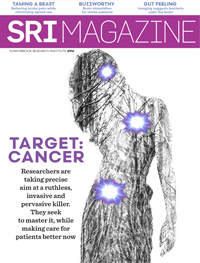Breaching the blood-brain barrier noninvasively: an historic first

Roughly 20 years: that’s how long it took for Dr. Kullervo Hynynen to see his research do what he always knew it could do, if he just kept working at it. On Nov. 5, 2015, something extraordinary happened, something that heralds a new era of hope for treatment of the most intractable brain diseases. On this day, neurosurgeons and physicists at Sunnybrook successfully breached the blood-brain barrier of a patient with brain cancer, to deliver chemotherapy directly into her brain. It was the first time in the world that this had been done. For Hynynen, it was a culmination of two decades’ worth of invention, experimentation and validation, first in the lab, then in preclinical research and finally with industry to commercialize the device.
In 1996 he was the first to describe a controlled, reversible and reproducible way of using focused ultrasound to open the blood-brain barrier under the guidance of MRI. This was once deemed impossible, given the impenetrable nature of the barrier, which protects our brains but also blocks access to 97% of drugs that might save our lives. Hynynen, director of Physical Sciences at Sunnybrook Research Institute (SRI), did not think it impossible. Now, the skeptics don’t, either.

Dr. Kullervo Hynynen (right-centre) and Dr. Todd Mainprize (centre-back) watch intently as focused ultrasound and microbubbles are used to open the blood-brain barrier in a patient with a brain tumour, so that chemotherapy can be delivered, a world first. Hynynen developed the technology. Mainprize is the lead investigator on the clinical trial.
Photo: Doug Nicholson
The patient, Bonnie Hall, has lived with brain cancer for eight years; recently, her tumour became aggressive. Under the care of Dr. Todd Mainprize, the lead neurosurgeon of the clinical trial testing if the strategy can be done and is safe, she agreed to be the first patient to have the procedure, even though it won’t change her prognosis. Her motivation, she said, is to help others. During the procedure, the team, sardined in the MRI control room, on the other side of which lay Hall in the scanner with the helmet-like device attached to her head, was as one, glued to the monitors. They held their collective breath, only to exhale exultantly when they saw the focused ultrasound and microbubbles do just what they were designed to do: open the blood-brain barrier, through which the chemotherapy slipped, travelling to its plotted destination, the tumour. Hynynen gave a thumbs up. There wasn’t a smileless face in the room.
Hall came out of the procedure tired but happy to hear that it had succeeded. The Phase 1 clinical trial continues, as does Hynynen’s life’s work. Next in line is harnessing focused ultrasound with a different scourge top of mind: Alzheimer’s disease. Partnering with him is SRI neuroscientist Dr. Isabelle Aubert. Together, they have already scaled several “firsts”: They delivered antibodies into the brains of mice to clear the “sticky plaque” that marks the disease; they used focused ultrasound alone and with therapeutics to restore memory and learning, and create new brain cells; and they used focused ultrasound to deliver gene therapy to targeted brain regions, where it reduced plaque load—seminal advances, indeed, given that by 2030 this pitiless condition will hit 75 million people globally.


 Breaching Barriers: A look at the promise of focused ultrasound to outsmart the brain’s natural defenses and smuggle therapies into deep-brain territory to treat intractable disorders of the central nervous system
Breaching Barriers: A look at the promise of focused ultrasound to outsmart the brain’s natural defenses and smuggle therapies into deep-brain territory to treat intractable disorders of the central nervous system
